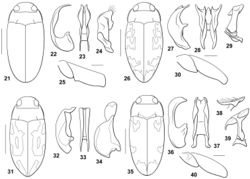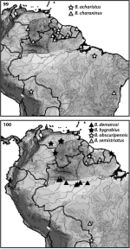Bidessodes charaxinus
| Notice: | This page is derived from the original publication listed below, whose author(s) should always be credited. Further contributors may edit and improve the content of this page and, consequently, need to be credited as well (see page history). Any assessment of factual correctness requires a careful review of the original article as well as of subsequent contributions.
If you are uncertain whether your planned contribution is correct or not, we suggest that you use the associated discussion page instead of editing the page directly. This page should be cited as follows (rationale):
Citation formats to copy and paste
BibTeX: @article{Miller2017ZooKeys, RIS/ Endnote: TY - JOUR Wikipedia/ Citizendium: <ref name="Miller2017ZooKeys">{{Citation See also the citation download page at the journal. |
Ordo: ORDO
Familia: FAMILIA
Genus: Bidessodes
Name
Bidessodes charaxinus Young, 1986 – Wikispecies link – Pensoft Profile
- Bidessodes (Bidessodes) charaxinus Young, 1986: 213; Biström, 1988: 7; Nilsson, 2016: 98.
Diagnosis
This species does not have a carinate prosternum in either male or female. The prosternal process is impressed longitudinally. The lateral margins are slightly convergent apically to the broadly pointed apex. The male mesotibia is elongate, curved, not basally bent. The male metatrochanter and metafemur are not noticeably modified (Fig. 30). The male abdominal ventrite VI is apically somewhat impressed. The male median lobe in lateral aspect is broad with a broad elongate basal region and an apical region that is broad basally and abruptly tapered to an elongate slender apex with a distinct subapical pointed process representing the apicomedial portion of each ramus (Fig. 27). In ventral aspect the median lobe is complex and deeply bifid with each ramus elongate, broad and apically terminating in two sharply pointed processes, and also with a medial terminal lobe between each lateral ramus (Fig. 28). The basal segment of the lateral lobe is small, irregular, and transverse (Fig. 29). The apical segment is broad and complex, terminating in a broad, transverse structure (Fig. 29). Specimens are relatively large and maculate (Fig. 26).
Distribution
Known from northern South America (Venezuela, Suriname, Guyana, French Guiana) south into Brazil (Fig. 99).
Taxon Treatment
- Miller, K; 2017: A review of the Neotropical genus Bidessodes Régimbart, 1895 including description of four new species (Coleoptera, Adephaga, Dytiscidae, Hydroporinae, Bidessini) ZooKeys, (658): 9-38. doi
Images
|

